This post may contain affiliate links. Please see our disclosure policy.
Canning sauerkraut is an easy way to preserve cabbage right on the pantry shelf. While plain cabbage is not approved for canning, it can be put up in a simple water bath canner once it’s made into sauerkraut.

Table of Contents
- Reasons for Canning Sauerkraut
- Reasons Not to Can Sauerkraut
- Making Sauerkraut for Canning
- Best Type of Cabbage for Canning Sauerkraut
- Ingredients for Canning Sauerkraut
- How to Make Sauerkraut for Canning
- How to Can Sauerkraut
- Using Canned Sauerkraut
- Other Ways to Store Sauerkraut
- Canning Sauerkraut Recipe
- Water Bath Canning Recipes
- Food Preservation Recipes & Techniques
Canning sauerkraut is a great way to store cabbage for the long term. When cabbage is first fermented into sauerkraut, it becomes acidic enough for canning, and it also becomes more digestible and nourishing.
I know the die-hard fermentation lovers out there are thinking, but doesn’t canning kill the probiotics?!?!?
Yes, it does.
When canned, sauerkraut will no longer contain live cultures, but believe it or not, the “probiotics” aren’t the only good reason to make sauerkraut. Fresh probiotic sauerkraut has its place, but so does home-canned sauerkraut.
Reasons for Canning Sauerkraut
Home canned sauerkraut may not be probiotic anymore, but it still has many benefits.
Turning cabbage into sauerkraut makes it more digestible, and it also increases protein and vitamin content. Sauerkraut, believe it or not, actually has more protein than the cabbage started with, as the lactobacillus work to convert the sugars within the cabbage into more nutrition.
Most historical recipes using sauerkraut actually first preserved the cabbage through fermentation but then went on to cook it before serving. These days, we tend to use it as a condiment on top of hot dogs, but back in the day, it was part of the cooked main course.
Think sausage and sauerkraut hash, or a full-on sauerkraut soup.
Neither of those uses are probiotic, but they’re still incredibly nourishing, and they allow you to enjoy nutrient-dense sauerkraut all winter long, and in much larger portions than you’d get when using it as a mere condiment.
If you live in a hot climate, canning sauerkraut is one of the best ways to store cabbage, as you likely don’t have a cool basement root cellar and refrigerator space is always limited. Sauerkraut will keep quite a while if kept cool, but that’s not exactly an option in the heat of summer in Texas.
Reasons Not to Can Sauerkraut
Of course, while canning has its place, be aware that the canning process is a sterilization process. The sauerkraut will not longer be probiotic, and if that’s your main goal in making sauerkraut, then I’d suggest storing it in the refrigerator for long-term use.
Saurkraut will keep for months if put in the refrigerator and quite a long time if just kept in a cool place like a basement.
(There are a number of other non-probiotic recipes for canning cabbage in traditional relish recipes that are most commonly called chow chow or piccalilli, like Southern Chow Chow or New England Piccalilli. They’re great options if you’re looking for a way to preserve cabbage on your pantry shelf.)
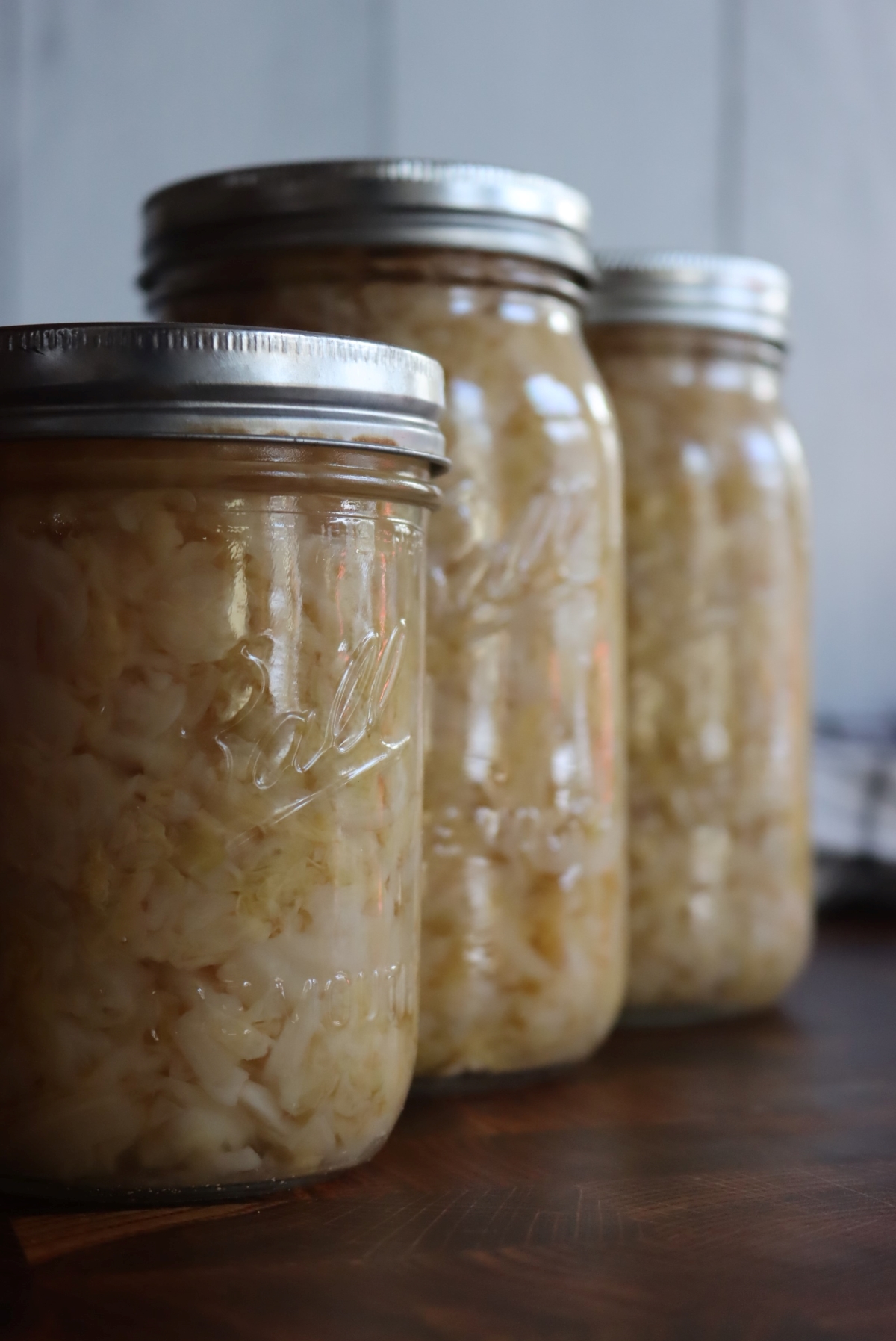
Making Sauerkraut for Canning
If you’re interested in making your own sauerkraut with the intention of canning it, there are two main components to consider beyond the actual ingredients: the amount of space and time needed for the cabbage to ferment.
Just the other day I saw someone excitedly post to a food preservation group that they’d acquired 5 cases of cabbage at for a few dollars and that they planned to spend the day canning sauerkraut. The thing is, you can’t buy cabbage today and can sauerkraut tomorrow. Before the canning stage, you’ll need to prepare the cabbage for sauerkraut and then let it ferment—a process that takes 3 to 6 weeks depending on the ambient temperature surrounding the fermentation container. Basically, the cooler the temperature is, the longer it takes for adequate fermentation to occur.
According to the Complete Guide to Home Canning from the National Center for Food Preservation, “Sauerkraut fermentation can take place under variable temperature and time combinations. For obtaining a good quality sauerkraut at home, the USDA recommendation is to store at 70º to 75ºF while fermenting. At temperatures between 70º and 75ºF, kraut will be fully fermented in about 3 to 4 weeks; at 60º to 65ºF, fermentation may take 5 to 6 weeks. At temperatures lower than 60ºF, kraut may not ferment. Above 75ºF, kraut may become soft.”
Be sure that your sauerkraut is fully fermented before canning. The acidity developed in the fermentation process is what makes the sauerkraut safe for canning, so this process can’t be rushed.
Best Type of Cabbage for Canning Sauerkraut
But first thing’s first! Choosing the type of cabbage for your sauerkraut. There are several types that can be used to make fermented sauerkraut, with the most popular and readily-available varieties being:
- Green cabbage (also called white cabbage) has a pleasant texture that will stay crunchy even after being fermented and canned. Green cabbage has a “clean” taste and is a good variety to use when it’s your first time making fermented sauerkraut.
- Red cabbage (also called purple cabbage) has an earthier flavor and contains more nutrients than green cabbage—particularly vitamin A, C, and iron. Red cabbage has also been found to contain more antioxidants than other types of cabbage.
- Napa cabbage is typically used for kimchi, another type of fermented cabbage preparation, and has a softer texture and milder flavor than other varieties of cabbage.
- Savoy cabbage tastes similar to green cabbage, but the green leaves are textured and softer. While it’s possible to ferment and can sauerkraut made from Savoy cabbage leaves, there’s a higher risk that the leaves will turn overly soft (and even mushy) during the fermentation process and canning stage. I’d recommend choosing Savoy cabbage if you already have experience making fermented sauerkraut.
Ingredients for Canning Sauerkraut
The only other ingredient you’ll need to make fermented sauerkraut is pickling salt (also called canning salt). Pickling salt is unique in that it doesn’t contain anti-caking agents, which means it dissolves easily and results in a clear, non-cloudy brine.
For this recipe, which yields about 9 finished quarts of fermented sauerkraut, I’m going to use roughly 25 pounds of whole cabbages. Instead of attacking all 25 pounds at once and being surrounded by a mountain of shredded lettuce, I like to work with 5 pounds at a time.
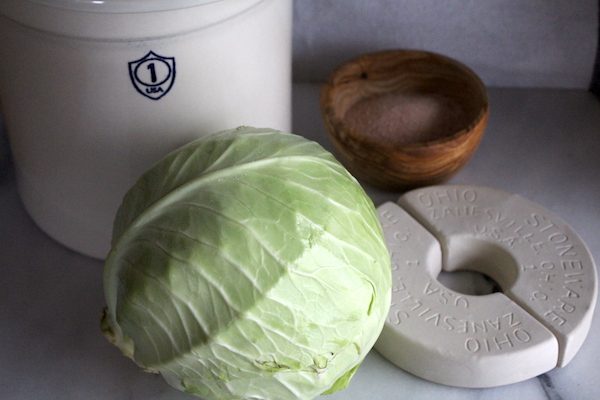
How to Make Sauerkraut for Canning
Discard the outer leaves first and rinse the cabbage heads under cool water. Using a sharp chef’s knife, cut each cabbage head into quarters and carefully remove the woody core. To thinly shred the cabbage into ribbons the thickness of a quarter, you can use a sharp knife, a food processor with a shredding attachment, or an inexpensive kitchen mandolin (but please, watch those fingers!).
Fill a fermentation container of choice with the shredded cabbage (I like to use a fermentation crock, bonus points if it comes with its own wooden pounder—if not, you can use a wooden spoon with similar results). Add 3 tablespoons of pickling salt to every 5 lbs of shredded cabbage in the crock and mix thoroughly with clean hands. Using a wooden fermentation pounder or wooden spoon, pound the salted cabbage until the salt begins to draw from the cabbage.
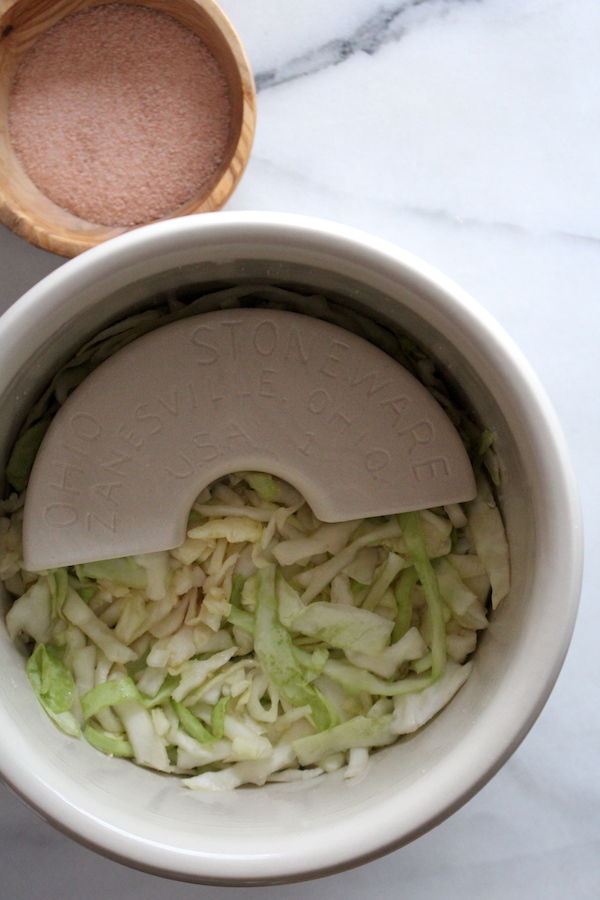
Keep repeating these steps until the crock is packed with all the salted cabbage. The fermentation container should be deep enough that there are 4 to 5 inches of the container left above the cabbage. The shredded, salted, and pounded cabbage should release enough juice/natural brine to completely cover the cabbage.
If you’re confused at all about the process, I’d suggest reading my guide that covers how to make sauerkraut, or more specifically, how to make sauerkraut in a crock.
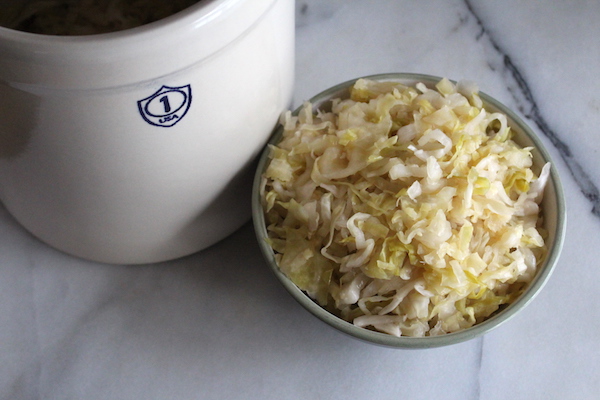
Depending on the size of your fermentation vessel, there’s a good chance you’ll need more than one crock—which means you’ll need more space, so keep this in mind during the initial planning stages.
How Long to Ferment Sauerkraut?
If sauerkraut is left to ferment at warmer temperatures (between 70° and 75°F, which is what the USDA recommends), it will take about 3 to 4 weeks for the cabbage to ferment. If the temperatures are slightly lower, between 60° and 65° degrees, the fermentation process will likely take 5 to 6 weeks.
Avoid fermenting the cabbage at temperatures higher than 75°F, this will result in mushy, inedible “sauerkraut.” On the other hand, temperatures lower than 60°F are too cold for proper fermentation to occur.
Why are these temperatures so important? In order for sauerkraut to be safely canned, it must be acidic enough (which naturally happens during fermentation).
On the topic of acid: While it’s technically possible to can pickled cabbage in white or cider vinegar, it wouldn’t have any of the amazing nutritional benefits from fermentation, and the taste would likely be pretty unpleasant.
You can expect to see signs of fermentation at around one week. Look for small bubbles—they’re easy to miss, and if the temperature is on the lower end you might not see them at all. If water levels look low, replenish with a bit of water. Brine might seem like a natural choice, but since it was water that evaporated from the crock originally (leaving behind salt) you could up with super-salty sauerkraut. Keep the shredded cabbage weighed down with fermentation weights and cover with a clean towel.
When is Sauerkraut Done?
Begin sampling the sauerkraut fairly early on. There are no hard-and-fast rules about when sauerkraut is finished, it mostly comes down to personal preference. Generally speaking, the longer the cabbage is allowed to ferment, the more complex the flavor. As mentioned above, depending on the ambient temperature, the sauerkraut is ready for canning after 3 to 6 weeks of fermentation.
Once the fermented sauerkraut is to your taste, it’s time for canning. Of course, you can always tightly cover the sauerkraut and store it in the refrigerator for several months in lieu of canning.
If you’re not familiar with fermenting tools and equipment, I’d suggest reading this beginner’s guide to lacto-fermentation. You can find more information specific to sauerkraut in this post on how to make sauerkraut as well as this one on making large batches of sauerkraut in a crock.
How to Can Sauerkraut
Sauerkraut is ready to be canned in a hot water bath canner using either a raw pack or a hot pack once the fermentation process is complete (in other words, to your particular liking).
Canning Sauerkraut with Raw Pack
To use the raw pack method, fill nine prepared quart jars with the sauerkraut, leaving 1/2-inch headspace at the top. Cover the contents of the jar with brine from the fermentation crock.
Canning Sauerkraut with Hot Pack
For canning sauerkraut using a hot pack, slowly warm the cabbage and the brine in a large, heavy-bottomed stock pot stirring frequently until the contents come to a boil. Remove the pot from the heat. Again, fill each quart jar with the sauerkraut and cover with hot brine, leaving 1/2-inch headspace.

Regardless of the method used, seal each jar with two-piece canning lids until fingertip tight. Load the jars into a prepared hot water canner and process for the time indicated below. Make sure to consider the altitude you’ll be canning at, as this can affect processing times.
When the timer goes off, turn off the heat and let the jars sit in the still-hot water for another 5 minutes. Using a jar lifter, carefully remove each jar from the hot water canner. Place the jars on a clean towel, leaving at least an inch of space between each jar, and let the sauerkraut come to room temperature (this usually takes anywhere from 12 to 24 hours).
At this point, you can check the seals on each jar, storing any unsealed jars in the fridge, where they’ll keep for up to 3 weeks. Remove the bands from the sealed jars and store the canned sauerkraut in a cool, dry location away from direct light.
How Long Does Canned Sauerkraut Last?
Unopened canned sauerkraut will easily last for 18 months if stored away from light, dampness, and heat. Once opened, it should be stored in the refrigerator and eaten within 1 week. Of course, you’ll find that canned sauerkraut can often last much longer than that as long as it doesn’t change color or develop any offensive smells.
Using Canned Sauerkraut
Beyond a topping for hot dogs and hamburgers, there are plenty of ways to make use of canned sauerkraut.
You can use it as a base for this Polish casserole, which also contains pasta, kielbasa, and shredded Swiss cheese. For a warming winter bowl of comfort, why not make a traditional sauerkraut soup recipe?
Bratwurst and sauerkraut are a natural pairing, try serving it with your favorite spicy mustard and a side of pickles. Last but not least, a homemade reuben sandwich doesn’t get much better when it’s been made with canned sauerkraut from your own pantry.
Other Ways to Store Sauerkraut
If you’re looking for other ideas for storing fermented sauerkraut that doesn’t involve canning, you can always try keeping it in a cool back closet, in the refrigerator, or in a not-too-damp basement. It’ll continue to ferment slowly, and it’ll get more acidic over time, but it should last many months so long as it’s kept in a cool dark place.
If you live in a hot area, the American West, it’s best to either keep your sauerkraut in the refrigerator or can it so you can keep it on the pantry shelf.
No matter which method you choose, the most important thing to remember is that the sauerkraut must be submerged under its liquid at all times. When any part of the sauerkraut is exposed to air, it will begin to mold and spoil. Be sure to keep the brine topped off if you’re storing fresh sauerkraut.
(This isn’t an issue when canning sauerkraut, as the jars are sealed and they won’t lose liquid over time.)
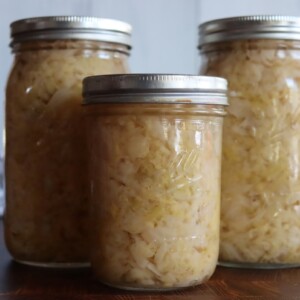
Canning Sauerkraut
Ingredients
- 25 lbs cabbage, whole
- 3/4 cup pickling salt, or canning salt or kosher salt
Instructions
- Working with 5 pounds of cabbage at a time, remove outer leaves and carefully wash each cabbage. Quarter and core each cabbage.
- Using a sharp knife, mandolin, or food processor with shredded attachment, shred the cabbage into thin ribbons the thickness of a quarter.
- Pack shredded cabbage into a fermentation crock.
- Add 3 tablespoons of canning/pickling salt to the cabbage in the crock and mix together with clean hands. (You'll need about 3 tablespoons for every 5 lbs of cabbage, so keep adding in 3 tbsp increments for each 5lb batch you work thoroughly.)
- Using a fermentation pounder or wooden spoon, pack the shredded and salted leaves tightly into the crock. Leave 4 to 5 inches of space at the top.
- Repeat this process with the remaining cabbage and salt, packing it into each fermentation crock. The salt will work to draw liquid from the cabbage, which should be submerged in this natural brine after a couple of hours.
- Cover the cabbage with your choice of fermentation weights so that it is entirely covered by liquid.
- Allow the sauerkraut to ferment over 3 to 6 weeks, depending on the ambient temperature around the crock and how strong you like your sauerkraut. Colder temperatures mean the fermentation process will be slower, warmer temperatures can speed the process up. Do a taste test frequently to check on the fermentation process.
- If at any point you notice the liquid level decreasing, cover the sauerkraut with fresh, unchlorinated water to keep the sauerkraut below the brine level.
- The total fermentation time depends on your preference, but it should ferment at least 4 weeks at room temperature (68 to 72 degrees) to be acidic enough for canning (see notes). Most people opt for around 6 weeks for best flavor. When the sauerkraut is to your taste preference, it can be preserved using either a raw pack or a hot pack.
- Raw pack method: fill each prepared quart jar with sauerkraut and its liquid (make sure the liquid is completely covering the sauerkraut). Leave 1/2-inch of headspace and apply two-part lids until fingertip tight.
- Hot pack method: heat sauerkraut and juices in a large, heavy-bottomed pot until boiling, being sure to stir frequently. Fill prepared quart jars with the hot sauerkraut and liquid. Leave 1/2-inch of headspace and apply two-part lids until fingertip tight.
- Wipe the sides of each jar with a clean cloth and load into a prepared hot water bath canner.
- Process the sauerkraut using the time recommended in the above chart (25 minutes for raw pack, 15 minutes for hot pack). If canning at a higher altitude, take note of longer processing times.
- When the timer goes off, turn off the heat and let the jars sit in the hot water canner for another 5 minutes.
- Carefully remove the jars from the hot water canner using a jar lifter.
- Place the jars on a clean towel, leaving 1-inch of space between each jar, and let the contents come to room temperature (12 to 24 hours).
- Check the seal on each lid, moving any unsealed jars to the refrigerator for storage.
- Remove the band from successfully canned jars of sauerkraut for another use and store in a cool, dry area away from direct light for up to 18 months.
Notes
Nutrition
Nutrition information is automatically calculated, so should only be used as an approximation.
Water Bath Canning Recipes
Looking for more easy water bath canning recipes?
Food Preservation Recipes & Techniques
Try preserving without canning this season!
- Storing Eggs in Lime
- How to Make Cheddar Cheese
- Homemade Apple Cider Vinegar
- Salt Cured Egg Yolks
- Storing Cheese in Wood Ash

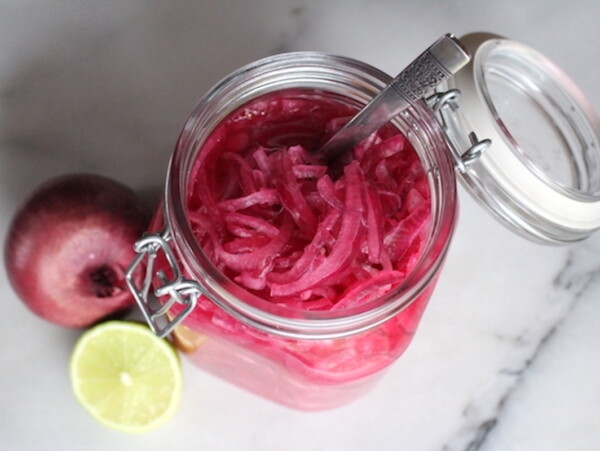
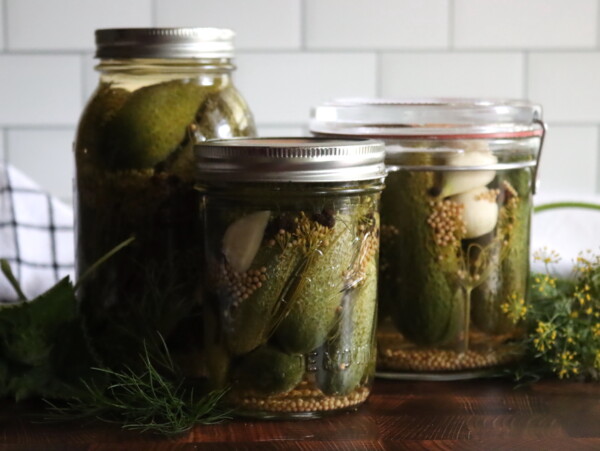

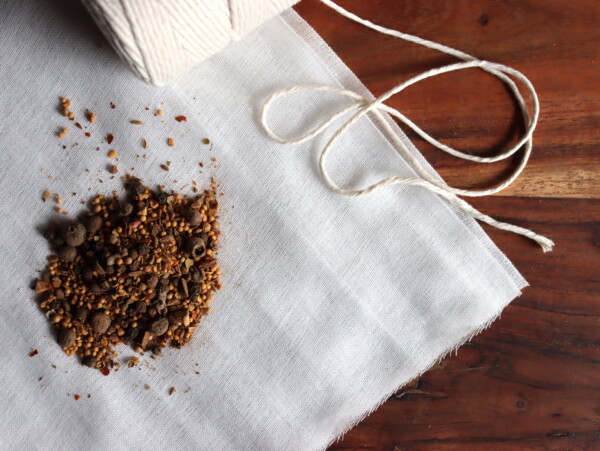
Love this recipe.
So glad you like it!
If I don’t have enough brine to cover the sauerkraut in each jar can I use boiled water to completely cover the sauerkraut?
You should use vinegar (white or cider) to cover he balance. Water will reduce the acidity, and it’s the acidity from fermentation that makes this safe for canning.
I used food grade 5 gallon buckets and it worked the same as a crock.
Yup, those work great! All you have to do is come up with a way to keep everything submerged under the brine, but there are plenty of options for that if you’re creative. Even water in a gallon ziploc bag works to keep everything weighed down. Glad it worked for you, and hope your canning project went just as well!
Hi! I’m interested in trying this recipe. Do you process this in a hot water bath or a pressure cooker? I’ve only used the oven method to can preserves. Thanks.
P.S. I like the idea of using a food-grade 5 gallon bucket. That would really simplify things!
This recipe is for a waterbath canner. The cabbage becomes acidic during fermentation, so you can safely waterbath can it even though it’s a vegetable. Enjoy!
So after the fermentation is finished and I would like to can the sauerkraut, would the heating from water baths kill the probiotics? I really want to keep the probiotics 😀
If you can it, then yes, it does kill the probiotics. There’s no way to can it without killing off the probiotics, but that said, much of their benefit is in the fermentation itself, rendering the cabbage more nutritious and digestible. I talk about this a good bit in the article, and there are many traditional recipes that use cooked sauerkraut, and this canned version is great in those. If your primary goal is the probiotics though, you should refrigerate the kraut instead of canning and use it within a few months.
Hi Ashley,
We’re Jeff and Michelle Van Pelt from Churubusco, Indiana.
We do “alot” of cooking and a ton of Canning/Pressure Canning/preserving foods.
We’ve always been intrigued by fermentation, but never took the step until a friend of mine at work was telling me how really easy is to make Sauerkraut. So we took the leap.
I checked out a dozen sites and kept coming back to yours. “Very” thorough. Thank you.
So… we converted some measurements of yours, and did a smaller batch of about 8 pounds. We didn’t have a crock and didn’t want to invest in one until we found out if it was worth it, so actually, we used our crock and it worked like a charm.
3 weeks??? Sauerkraut was perfect. Thanks again.
So we kept some fresh in the refrigerator and canned the rest in pint jars. We both loved the benefits of the the Probiotics.
Then we broke into the canned stuff and sure enough, the Probiotics are dead, so I have another batch fermenting as I write this.
I got to thinking, I wonder if I could crack open a seal on one of my pint jars with the canned Sauerkraut and just let it set on the counter with the lid loose… Would it referment? 🤔
I Googled this subject in several ways and came up with nothing, so I came back here to see if you’ve ever tried this.
I want to thank you again for that awesome recipe. My Wife has never like Sauerkraut in her life. She’s only had store bought. She loves it.
So you could get it to re-ferment, but you’d have to add a culture to get some live lactobacillus back into the jar. To do that, you’d crack the jar, add a tablespoon or two of yogurt whey (or brine from another active lacto ferment, like a live batch of sauerkraut) and give it a few days. That will bring it back to life. Great idea!
Do you have to use a crock to ferment the sauerkraut? I don’t have one so I’m wondering if I can ferment it in the mason jars?
Yup, you can ferment it in mason jars, that’s fine. Half gallon ones work really well for it, but quarts are fine too. Be sure to take it out of the jars and heat it before canning so it’s a hot pack.